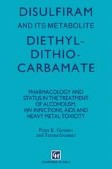Search
Search Results
-
Disulfiram therapy of alcohol abuse
Disulfiram (DSSD) administration results in the inhibition of E2, the mitochondrial aldehyde dehydrogenase (ALDH) that is the enzyme responsible for...
-
Amitraz-induced glucose intolerance in rats: antagonism by yohimbine but not by prazosin
Amitraz (N′-[2,4-dimethylphenyl]-N-[(2,4-dimethylphenyl)imino]-N-methylmethanimidamide) is a formamidine insecticide/acaricide that increases plasma...
-
The Use of Radio-Thin Layer Chromatography in Pesticide Environmental Studies
All novel pesticides are investigated for their degradation rate and route in the environment prior to obtaining company and government approval to...
-
Monoamines as Targets for Insecticide Discovery
Although many chemical insecticides are available for crop protection, grain storage, homeowner and public health uses, the majority of these...
-
Diazinon resistance in Lucilia cuprina; map** of a fitness modifier
Modification of the fitness of diazinon resistance genotypes of the Australian sheep blowfly, Lucilia cuprina , in the absence of the insecticide from...
-
Ultrastructural localization of acetylcholinesterase in the synganglion of the tick, Dermacentor variabilis (Say)
Light- and electron-microscopic enzyme cytochemistry was used to localize acetylcholinesterase (AChE) activity in the synganglion (brain) of the tick D...
-
Interaction of the pesticide chlordimeform with adrenergic receptors in mouse brain: an in vitro study
Chlordimeform (N'(4-chloro- o -tolyl)-N, N-dimethylformamidine; CDM) is a formamidine insecticide/acaricide whose major active metabolite is its...
-
Evaluation of the Genotoxic Potential of Certain Pesticides Used in Pakistan
The mutagenicity of fifteen insecticides, five fungicides, four herbicides, and an acaricide commonly used in Pakistan was evaluated by employing...
-
Classification of Insecticides
The development of new insecticides in the past three decades has been so rapid that no single book can adequately cover all the insecticidal...
-
Modes of Action of Insecticides
The modes of action of various drugs and poisons have fascinated mankind since the age of witchcraft-medicine. As stated before, insect toxicology is...
-
Control of bovine babesiosis
Bovine babesiosis occurs on all five continents, and is particularly devastating in the tropics and sub-tropics where most of the world’s cattle...
-
Epidemiology of babesiosis
Levine [1] identified 71 species within the genus Babesia. Our knowledge of the epidemiology of these organisms and the diseases that they may cause...
-
Mutagenicity, Carcinogenicity, and Teratogenicity of Insecticides
The origin of insecticides is rooted in antiquity. Plinius the Elder recommended arsenic to kill insects as early as 70 A.D. Arsenic sulfide is...
-
Congenital Defects of Domestic and Feral Animals
A variety of structural and functional defects have been described in newborn animals ranging from variant and blemish, imperfection and deviant, to...
-
Cytokinetic and cytogenetic effect of agricultural chemicals on human lymphoid cells in vitro
Human lymphoid cells of LAZ-007 cell line, incubated with 10 −4 to 10 −6 molar of eight different organochlorine pesticides had dose related...
-
Physiological, pharmacological and therapeutic aspects of some gastrointestinal disorders in the horse
A high incidence of acute abdominal diseases is recognized in horses. A retrospective study of causes of death indicates that the alimentary tract...
-
Adverse drug reactions and interactions (1979–1981)
The 1200 adverse reactions to antibiotics reported in cattle by Brisbane in Alberta2referred to anaphylaxis with dispnoea, slobbering, staggering and...
-
Heavy metal intoxications in horses
Intoxication of horses by heavy metals is of comparatively uncommon occur rence, and mostly the diseases are chronic in type. Usually, poisoning is...
-
The Australian School of Parasitology: Current Status and Prospects
The proceedings of a previous conference on parasitology in the United States,and the other contributions in this volume on the more global picture,...
